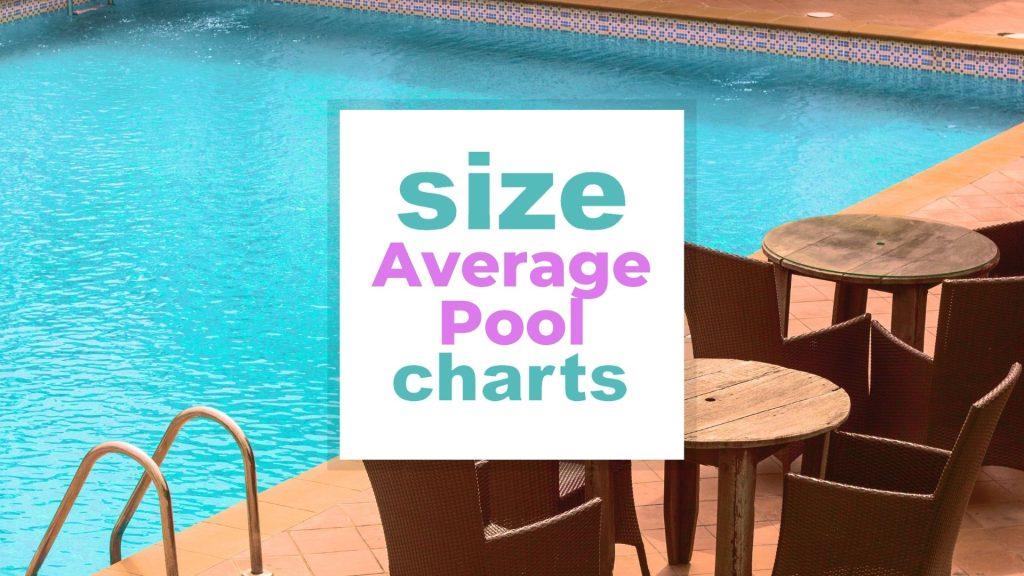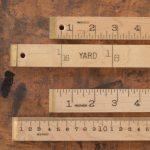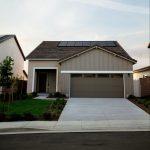Average Pool Size Explained by Type of Pool
A swimming pool can be a great asset to your home. But what size of pool do you need? Find out in this average pool size article.
Building or installing a pool can be a time and money-consuming project. That’s why you should find out the best size before diverting resources to get one. In this post, we’ll cover the average pool size and how to choose the right pool.
Jump immediately to the frequently asked Questions section on swimming pool sizes

What is a swimming pool, and why is an average pool size important?
Swimming pools are structures designed to hold a pool of water, allowing you to swim. They are great for cooling down in the summer when temperatures are high. You can also use a swimming pool for exercise, reducing stress, bonding with family and friends, and physical therapy. A pool can also increase the value of your home if you plan to sell it in the future.
Let’s dive in! (pun intended)
Table of Content of Average Pool Size
- Average Pool Size Charts
- How to Choose the Right Pool Size
- Average pool size video
- Which is The Best Pool for You?
- Frequently Asked Questions: what other people ask
- Conclusion
When going to a pool you need a towel, check out the beach towel sizes here
Related: average pool sizes, Olympic Pool sizes, standard pool sizes by type and shape, …
Average Pool Size Charts
Average Rectangular Pool Sizes
| Rectangular Pool Size | 3.5 ft Avg Depth | 4 ft Avg Depth | 4.5 ft Avg Depth | 5 ft Avg Depth |
| 12 x 24 ft 3.7 x 7.3 m | 7,600 gal 28,769 L | 8,600 gal 32,554 L | 9,700 gal 36,718 L | 10,800 gal 40,882 L |
| 14 x 28 ft 4.3 x 8.5 m | 10,300 gal 38,989 L | 11,800 gal 44,667 L | 13,200 gal 49,967 L | 14,700 gal 55,645 L |
| 15 x 30 ft 4.6 x 9.1 m | 11,800 gal 44,667 L | 13,500 gal 51,103 L | 15,200 gal 57,538 L | 16,900 gal 63,973 L |
| 16 x 32 ft 4.9 x 10 m | 13,400 gal 50,724 L | 15,400 gal 58,295 L | 17,300 gal 65,487 L | 19,200 gal 72,679 L |
| 18 x 36 ft 5.5 x 11 m | 17,000 gal 64,352 L | 19,400 gal 73,436 L | 21,900 gal 282,900 L | 24,300 gal 91,985 L |
| 19 x 38 ft 5.8 x 11.6 m | 19,000 gal 71,922 L | 21,700 gal 82,143 L | 24,400 gal 92,364 L | 27,100 gal 102,584 L |
| 20 x 40 ft 6.1 x 12.2 m | 21,000 gal 79,493 L | 24,000 gal 90,849 L | 27,000 gal 102,206 L | 30,000 gal 113,562 L |
| 22 x 44 ft 6.7 x 13.4 m | 25,400 gal 96,149 L | 29,000 gal 109,776 L | 32,700 gal 123,783 L | 36,300 gal 137,410 L |
| 25 x 45 ft 7.6 x 13.7 m | 29,531 gal 111,787 L | 33,750 gal 127,757 L | 37,968 gal 143,724 L | 42,187 gal 159,695 L |
| 25 x 50 ft 7.6 x 15.2 m | 32,800 gal 124,161 L | 37,500 gal 141,952 L | 42,200 gal 159,744 L | 46,900 gal 177,535 L |
| 30 x 50 ft 9.1 x 15.2 m | 39,375 gal 149,050 L | 45,000 gal 170,343 L | 50,525 gal 191,257 L | 56,250 gal 212,929 L |
Average Round Pool Sizes
| Average Round Pool Size | Depth – 48” (1.2 m) | Depth – 52” (1.3 m) |
| 12’ (3.7 m) | 3,400 gal (12,870 L) | – |
| 15’ (4.6 m) | 5,000 gal (18,927 L) | 5,700 gal (21,577 L) |
| 18’ (5.5 m) | 7,600 gal (28,769 L) | 8,200 gal (31,040 L) |
| 20’ (6.1 m) | 10,000 gal (37,854 L) | 10,218 gal (38,679 L) |
| 21’ (6.4 m) | 13,500 gal (51,103 L) | 14,500 gal (54,888 L) |
| 24’ (7.3 m) | 17,000 gal (64,352 L) | 19,000 gal (71,923 L) |
| 28’ (8.5 m) | 18,000 gal (68,137 L) | 20,000 gal (75,708 L) |
| 30’ (9.1 m) | 21,000 gal (79,493 L) | 23,000 gal (87,064 L) |
Average Oval Pool Sizes
| Average Oval Pool Size | Depth 48 in (1.2 m) | 52 in (1.3 m) |
| 11’ x 18’ (3.4 x 5.5 m) | 5,000 gal (18,920 L) | – |
| 12’ x 24’ (3.7 x 7.3 m) | 7,600 gal (28,769 L) | 9,300 gal (35204 L) |
| 15’ x 25’ (4.6 x 7.6 m) | 10,000 gal (37,854 L) | 11,000 gal (41,639 L) |
| 15’ x 27’ (4.6 x 8.2 m) | 10,700 gal (40,503 L) | – |
| 15’ x 30’ (4.6 x 9.1 m) | 12,000 gal (45,424 L) | 14,800 gal (56,025 L) |
| 16’ x 32’ (4.9 x 9.8 m) | 13,600 gal (51,481 L) | – |
| 18’ x 33’ (5.5 x 10.1 m) | 17,400 (65,866 L) | 18,900 gal (71,544 L) |
| 21’ x 38’ (6.4 x 11.6 m) | 19,000 (71,923 L) | 22,100 gal (83,657 L) |
| 21’ x 41’ (6.4 x 12.5 m) | 23,000 (87,064 L) | 25,000 gal (94,635 L) |
How to Choose the Right Pool Size
There are several things to keep in mind when choosing the right pool size. We’ll discuss them below.
1. Standard pool sizes
The first thing to know is how to determine pool sizes. Usually, a pool with the least-interesting shape, like rectangular, round, or oval, will come in a predetermined size. Rectangular and oval pools are sized according to the length and width dimensions, while round ones use the diameter.
The depth of your pool is also crucial because it will determine who can swim in it.
Rectangular swimming pool sizes:
These are the most common in inground pool projects and come in the following average sizes:
- 12 x 24 ft (3.7 x 7.3 m)
- 14 x 28 ft (4.3 x 8.5 m)
- 15 x 30 ft (4.6 x 9.1 m)
- 16 x 32 ft (4.9 x 10 m)
- 18 x 36 ft (5.5 x 11 m)
- 19 x 38 ft (5.8 x 11.6 m)
- 20 x 40 ft (6.1 x 12.2 m)
- 22 x 44 ft (6.7 x 13.4 m)
- 25 x 45 ft (7.6 x 13.7 m)
- 25 x 50 ft (7.6 x 15.2 m)
- 30 x 50 ft (9.1 x 15.2 m)
Average round pool sizes include:
- 12 feet (3.7 m)
- 15 feet (4.6 m)
- 18 feet (5.5 m)
- 20 feet (6.1 m)
- 21 feet (6.4 m)
- 24 feet (7.3 m)
- 28 feet (8.5 m)
- 30 feet (9.1 m)
Average oval pool sizes include:
- 11 x 18 ft (3.4 x 5.5 m)
- 12 x 24 ft (3.7 x 7.3 m)
- 15 x 25 ft (4.6 x 7.6 m)
- 15 x 27 ft (4.6 x 8.2 m)
- 15 x 30 ft (4.6 x 9.1 m)
- 16 x 32 ft (4.9 x 9.8 m)
- 18 x 33 ft (5.5 x 10.1 m)
- 21 x 38 ft (6.4 x 11.6 m)
- 21 x 41 ft (6.4 x 12.5 m)
2. Price
Your budget is the next factor to keep in mind. You can’t build a pool you can’t afford, so you should find out how much you can spend on building the pool. The materials used for pool construction will determine the price range.
The most affordable opinion is vinyl pools both in terms of initial and ongoing maintenance costs. This is because it’s easy to clean, algae-resistant, and long-lasting.
If you want something in the middle price range, then consider concrete, shotcrete, or gunite pools. Unfortunately, maintaining concrete pools is expensive since it requires more chemicals and electric power. Regular removal of algae will gradually weaken the concrete structure, so you’ll need to resurface it after a while, adding to the pool maintenance cost.
On the higher end of the scale, we have fiberglass pools, the most expensive options. Fortunately, these pools are easier to maintain than the other options, and the installation can take as little as a week.
The long-term cost of your pool should be at the forefront of your mind because you could end up surprised by how much your pool will cost to keep in good condition. Other costs will come from powering the pool pump to handle thousands of gallons of water.
In addition to the pool, your project will probably include building a pool deck and adding aesthetics to the pool area. You can even get a pool with landscaping features if you have a high budget.
3. Location
There are two options for the location of your pool. It can be an above-ground or in-ground pool. Above-ground swimming pools are the more affordable option because they don’t require as much labor for excavation during installation. You can easily find this type of pool in the backyard.
Compared to an above-ground pool, an inground pool costs more because of the construction process. An underground pool is also more durable than one that’s above ground. However, they are the same in terms of maintenance requirements.
If you want a little of both worlds, you can choose an oasis semi-inground pool. This type of pool goes partly underground, with a section protruding above the surface. Above-ground pools will come in predetermined sizes, but you can customize the size of an inground pool according to your preferences.
3. Purpose
You should also find out why you want a pool in the first place and who will be using it before you choose a specific size. Your pool size could differ based on the purpose of the swimming pool. Are you an outgoing individual who loves to invite friends and family to hang out? If so, you should estimate the number of people using the pool simultaneously.
A pool party will probably have lots of people, and you’ll want a large-sized pool that can accommodate everyone. This will ensure your loved ones aren’t cramped up in a tiny pool where they can’t stretch out and have fun. You’ll want to ensure you have enough space for different activities like dives or pool volleyball.
Perhaps you only need a pool for exercise rather than leisure. In that case, you can consider traditional lap pools, which tend to be among the larger pool options. However, if there aren’t many people swimming with you, you can settle for an indoor lap pool. Once you know the purpose of the pool, you’ll be a step closer to finding the right size.
4. Available Space
The amount of space in your residence will also determine the pool sizes that you choose. You can’t choose a pool size that’s larger than your yard. The available room will tell you the most convenient pool size to invest in. Larger pools are suitable for areas without space limitations, while smaller pools are great for compact yards.
Your pool can’t take the entire yard space. You’ll need to leave some deck space if you’d like a deck for your pool. Extra space is also necessary if swimming isn’t the only activity in your backyard. If you like to barbecue while the kids have fun in the pool, you’ll probably need to split your yard into a swimming and patio section. Remember, it’s not always about being inside the water. Some people prefer to have a good time while sitting beside the pool while enjoying a drink or snack.
Average pool size explained (video)
Which is The Best Pool for You?
Now that we’ve covered the best pool sizes let’s look at the other features to consider.
1. Pool Shape
This is probably among the first things you’ll think about. Some pools come in predesigned shapes and others irregular shapes. The regular shapes, including rectangle, round, and oval, are more affordable than pools with creative shapes.
Rectangular pools are in the shape of a rectangle and tend to have a ratio of 1:2 for the width to length dimensions. This means that the length is normally twice as long as the width.
Round pools have a round circumference and are sized according to the diameter. They are a great option if you want to avoid corners in your pool. Plus, they can easily fit in small spaces compared to rectangular pools making them ideal for a small family.
An oval pool is the best option if you are caught between rectangular and round-shaped pools. They look elongated but have round edges giving them a unique look, and they cost less than round pools.
Kidney-shaped pools come in a kidney shape. The curve in this type of pool separates the deep and shallow ends, making it easier to stay where you are comfortable. Plus, they allow you to enjoy the same activities you like in rectangular pools.
A freeform pool is one that’s made using creative shapes. Kidney-shaped pools are a type of freeform pool. These pools have a freeform shape which means they can have as many curves and flowing lines as you want. However, they are more challenging for pool builders to make since they don’t have a straightforward shape.
2. Type of pool
There are many types of pools to choose from. Let’s briefly cover them in this section.Olympic swimming pool
This pool is used in a competition setting for the Olympic games. They are the largest swimming pools you can find and are designed to provide ample room for professional swimmers. They have large lane widths allowing you to perform swimming laps for practice or during a contest.
Plunge pools
Unlike a traditional pool that you use for swimming, a plunge pool is suitable for shallow wading and lounging. If you don’t have the yard space for a larger pool, this one will meet your needs perfectly.
Lagoon pools
These pools usually resemble natural water bodies thanks to creative landscaping designs. This backyard pool will take a freeform design and comes in a unique color to make it look natural.
Diving pool
This pool is specially designed for diving exercises. It’s a deeper pool than regular residential pools since users jump in from a great height. Usually, these pools can be up to 9 feet deep.
Community pool
No place or budget to place your own pool? You can always go to community pools. Check our sizing review here.
Olympic pool
Always fun to learn about olympic pool sizes
3. Style of pool
When it comes to pool design, you can go with a zero-entry or uniform depth design. A zero-entry pool or beach entry pool has a descending pool depth meaning the pool gets deeper as you walk further in. On the other hand, a pool with a uniform depth is the same on every side. These pools are great for kids and beginner swimmers.
4. Pool Water
The last thing to think about is the type of water you want in your swimming pool. You can choose between chlorine pools and saltwater pools. Chlorine water can fade your swimwear over time since chlorine is a bleaching agent. A saltwater swimming pool is an excellent choice if you want to avoid harsh chemicals since it’s more gentle on your skin, hair, and swimwear.
FAQ on Swimming pool sizing
1. What is the average size of an indoor pool?
Most indoor pools measure 30ft x 15ft (9.2m x 4.5m).
2. What is the average size of an outdoor pool?
The average size of an outdoor pool is 30.1 feet long, 15.7 feet wide and 5.6 feet deep (9.2 x 4.8 x 1.7 m).
3. What is the most popular pool size?
18 x 36 feet (5.5 x 11 m) is the most common pool size.
4. What is a good size swimming pool?
A good pool size should allow everyone to be in the pool without crowding or making it hard to play pool games.
5. Does average pool size change in different countries?
Yes, it does. This is because of different climates and requirements in various countries.
6. What is the average depth of a swimming pool?
Most pools have a depth of 5 feet (1.5 m).
7. What is a walk-in swimming pool?
A walk-in swimming pool is also called a beach entry pool because it gets deeper as you move in.
Conclusion
Swimming pools can provide many benefits for children and adults alike. However, pools aren’t the same in size, price, or maintenance. That’s why checking out the average pool sizes before starting your project is necessary.
If you have questions about swimming pool sizes, drop them below!
Picture in this post by John Fornander on Unsplash
Related Size charts on house and living
- Barbie Doll Size : What are different sizes of Barbie ?
- Blanket sizes chart : blanket sizes and dimensions in inches & cm
- Tablecloth size chart – What are standard tablecloth sizes ?
- How Many Meters Are In A Yard?
- How Many Centimeters are 8 Inches?
- Knife Sizes and Different Types
- 4 Inches is How Many Centimeters?
- Light Bulb Base Sizes : What size light bulb base do I need?
- Tesalate Towel Size Guide
- Light bulb Size : What are the different and standard bulb sizes?
- Duvet Sizes: What is a Standard-Size Duvet?
- Single Car Garage Size and Dimensions
- How High Is A Story?













